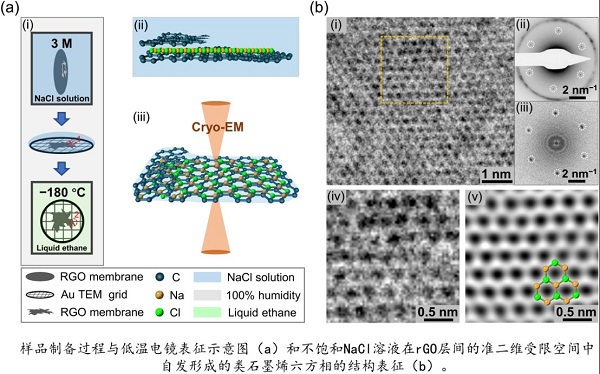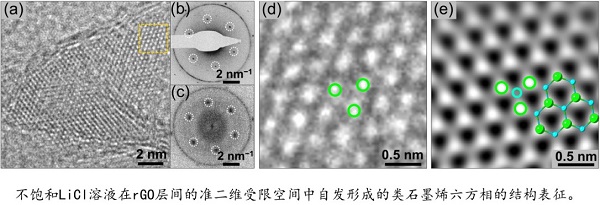First experimental evidence proves new state and property in aqueous environment
Researchers in Xi'an Jiaotong University (XJTU) observed the first experimental evidence for the independent and stable existence of graphene-like hexagonal NaCl phases under ambient conditions.

Based on the cryo-transmission electron microscopy technique, combined with a variety of experimental and theoretical analysis methods, the research groups of Professors Zhang Lei and Zhang Shengli from the School of Physics reported the reduction of graphene oxide (rGO) interlayer quasi-dioxide in aqueous environment under ambient conditions.
A stable graphene-like hexagonal phase (h-NaCl) spontaneously formed from an unsaturated NaCl solution in a dimensionally confined space, and the near-atomic resolution observation and in-situ characterization of this hexagonal phase was achieved.

(a) Schematic diagram of sample preparation process and cryo-EM characterization
(b) Structural characterization of graphene-like hexagonal phases spontaneously formed in quasi-two-dimensional confined spaces between rGO layers and unsaturated NaCI solutions
Under the same experimental parameters, the researchers also observed the graphene-like hexagonal phase (h-LiCl) formed between the rGO film layers by unsaturated LiCl solution in the aqueous environment, thus revealing a non-classical nucleation pathway for the alkali halide-like graphene hexagonal phase that widely exists between rGO layers.

Structural characterization of graphene-like hexagonal phases spontaneously formed in quasi-two-dimensional confined spaces between rGO layers from unsaturated LiCi solutions.
Combining control experiments, density functional theory (DFT) calculations and previous theoretical studies, it was revealed that a delicate balance of cation-π interactions between the solute and the rGO substrate, electrostatic interactions between anions and cations, solute-solvent interactions, and thermodynamics in confined spaces synergistically lead to the formation of this hexagonal crystal phase.
Titled Graphitic-like Hexagonal Phase of Alkali Halides in Quasi-Two-Dimensional Confined Space under Ambient Conditions, the research was published on ACS Nano. (Link to the paper: https://pubs.acs.org/doi/abs/10.1021/acsnano.1c07424)
Doctoral students Zhao Yimin and Zhang Quan are the co-first authors of the paper, and Zhang Lei and Zhang Shengli are the co-corresponding authors.

